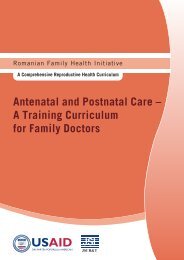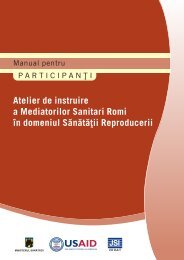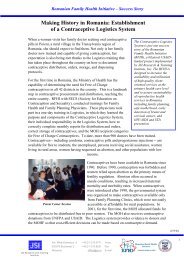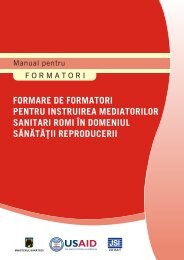Training of Roma Health Mediators in Reproductive Health
Training of Roma Health Mediators in Reproductive Health
Training of Roma Health Mediators in Reproductive Health
Create successful ePaper yourself
Turn your PDF publications into a flip-book with our unique Google optimized e-Paper software.
Other possible obstacles to hear<strong>in</strong>g what others say<br />
The mediator:<br />
• Mis<strong>in</strong>terprets what the woman says and th<strong>in</strong>ks the woman is criticiz<strong>in</strong>g her.<br />
• Prepares her response at the same time she listens to the woman.<br />
• Listens selectively (based on her experience with other women). We limit our<br />
understand<strong>in</strong>g <strong>of</strong> what people say by ignor<strong>in</strong>g details accord<strong>in</strong>g to our values and<br />
therefore our <strong>in</strong>terpretations <strong>of</strong> what was said.<br />
• Pays more attention to all that is not correct, or to that with which she doesn’t agree,<br />
<strong>in</strong> what the woman says.<br />
• Identifies with someth<strong>in</strong>g the woman said and beg<strong>in</strong>s to relive her own experiences.<br />
Other obstacles to communication:<br />
• Differences <strong>in</strong> values, education, class, vocabulary between the mediator and the<br />
woman may make it difficult for one to understand the other. <strong>Mediators</strong> may<br />
mis<strong>in</strong>terpret their roles <strong>in</strong> communication for behavior change, and:<br />
o Transform a dialogue <strong>in</strong>to a monolog<br />
o Not show respect towards the woman<br />
• The attitude that mediators have better ideas than community women<br />
• Extreme appearance (<strong>of</strong> the woman or the mediator)<br />
• The woman’s problem is shock<strong>in</strong>g<br />
• The mediator, or the woman, is distracted by other pre-occupations<br />
• The mediator’s response is not what the woman needed or wanted to hear<br />
• The environment is not conducive to communication (noisy, distract<strong>in</strong>g, no privacy);<br />
the woman is self-conscious to discuss problems because <strong>of</strong> the possibility <strong>of</strong> other<br />
people listen<strong>in</strong>g<br />
• The woman feels uncomfortable because she does not trust the mediator<br />
• The mediator does not understand the woman’s problem and gives advice or<br />
<strong>in</strong>formation that is irrelevant or impossible to apply<br />
• Too much <strong>in</strong>formation is given: the woman only remembers part <strong>of</strong> what was said,<br />
especially if she was worried or anxious<br />
• People who do not know each other or otherwise lack confidence <strong>in</strong> each other<br />
sometimes have difficulty hear<strong>in</strong>g each other<br />
• Women <strong>in</strong> the community may:<br />
o Fear express<strong>in</strong>g their ideas<br />
o Believe that their problems would not be <strong>of</strong> <strong>in</strong>terest to mediators<br />
• Previous experience – if previous encounters/communication did not lead to a<br />
change <strong>in</strong> behavior, the mediator may assume that future communication with this<br />
woman, or “women like her”, would be the same.<br />
• The woman’s sense <strong>of</strong> <strong>in</strong>security or <strong>in</strong>feriority may lead her to <strong>in</strong>terpret the<br />
mediator’s questions as accusations, and the woman’s answers turn <strong>in</strong>to<br />
justifications<br />
• The woman’s perception <strong>of</strong> the mediator as <strong>in</strong>competent (<strong>in</strong> terms <strong>of</strong> what the<br />
mediator says and how she says it)<br />
• The woman’s <strong>in</strong>terest <strong>in</strong> the subject, other preoccupations and/or attitude toward the<br />
mediator. If the woman is anxious or nervous, she may easily become defensive and<br />
mis<strong>in</strong>terpret what is said (<strong>in</strong>clud<strong>in</strong>g perceiv<strong>in</strong>g threats which are not there)<br />
228<br />
RFHI/JSI <strong>Roma</strong>nia <strong>Tra<strong>in</strong><strong>in</strong>g</strong> <strong>of</strong> RHMs <strong>in</strong> <strong>Reproductive</strong> <strong>Health</strong> Session 14: Interpersonal Communication








